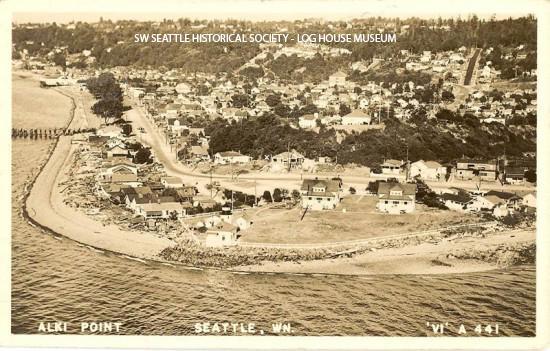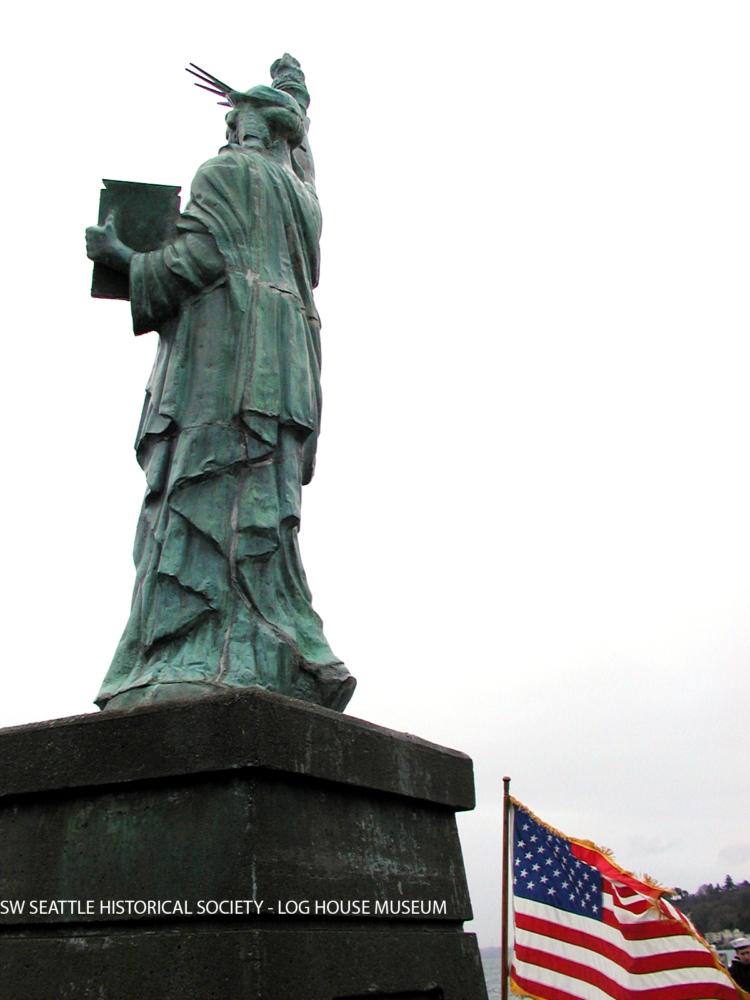|
Introduction Historian Flo Lentz explained on the National Register of Historic Places Registration Form, “West Seattle referred only to the settlement along the northeast portion of the Duwamish Peninsula. The Alki neighborhood is located in the northwest portion of the peninsula. Despite the nearby development of the original West Seattle, Alki remained a remote, private summer recreation area. In the 1880s and 1890s, the original West Seattle settlement established itself as an industrial and residential outgrowth of downtown Seattle. The Williamson, Phillips, and Plummer sawmill opened in 1864 along present day Harbor Avenue SW, southeast of the head of the Duwamish River. A community sprang up around the mill. Initially named Freeport, the settlement took the name Milton by 1877 and then West Seattle in 1888. In 1893, a flour mill and public school were both under construction on the northeast corner of the peninsula. In 1899, King and Winge Shipyard, one of the most prolific ship building operations in Seattle’s history, was located on the southwest portion of Duwamish Head. In 1902, West Seattle was officially incorporated as a municipality. Peninsula communities, including Alki remained separate and independent until Seattle annexed them all as a group in 1907 under the name West Seattle. In contrast, the Alki neighborhood remained quiet and sparsely visited. The sandy beach at Alki beckoned to swimmers and beachcombers. Alki beaches became popular summer vacation spots for city dwellers seeking rustic living. The privately run Coney Island Baths opened in 1899, west of Duwamish Head. In 1901, Albert A. Smith built the Stockade Hotel near the present intersection of 63rd Avenue SW and Alki Avenue SW. Alki Point had at least one other known beachfront resort named Rose Lodge. A public bathing beach was opened in 1901 and a natatorium in 1905. By 1905, photographs show canvas tents, private cabins, and vacation homes dotting the landscape. Historian Flo Lentz states that in July 1905 the local newspaper listed more than seventy-five beach cottages along Alki Avenue from the ferry landing to the natatorium. An amusement park, Luna Park, opened in 1907. Despite the summer visitors, there were few, if any year-round residents. However, Flo Lentz notes, the Alki neighborhood quickly evolved, “with permanent residences, commercial structures, a public school, a play field with golf links, and a church.” All helping the growth in West Seattle and Alki were different methods of traveling to the area in the late nineteenth and early twentieth centuries. Yet, these modes of transportation were not perfect and still made traveling permanently from Alki to Seattle difficult. Beginning in 1888, ferries crossed Elliott Bay, connecting downtown Seattle and West Seattle. Small steamships, collectively known as the Mosquito Fleet, also transported passengers to docks at Alki Beach and other points on the Duwamish Peninsula. These ferries, however, were only rafts of logs held together by ropes and propelled by men with pine-poles or they were allowed to drift with the current. According to Sophia Frye Bass, “The roads in West Seattle were seldom used, rough, and full of chunk holes. The easiest ways of travel were by canoe, sail boat, or plodding over wet sands when the tide was out.” In 1890, the Seattle Terminal Railway and Elevator Company built a trestle to the peninsula from the present Port of Seattle, bridging the south end of the Elliott Bay tidal flats. In later years, with people coming to the beach, the roads became better and a plank road boulevard was built along the shore over the water. In 1907, an electric streetcar began service from Seattle to West Seattle. All this new transportation brought a flood of visitors to Alki and transformed the beach to a busy resort area in the summers. After the arrival of the streetcar service, Alki continued to develop as a tourist destination and became a year-round community. Public recreational and civic facilities anchored the neighborhood. In 1910 the City of Seattle erected the Alki Bathing Pavilion and was opened in 1911. It served as a community gathering place and sports venue. A bandstand was completed in 1912 along Alki Beach Park. Commerce and new residents blossomed along present day Alki Avenue SW. Today, the Alki neighborhood is defined by continued recreational use of the waterfront. This self-guided walking tour of Alki represents some of the most historically significant and prominent sites. Beginning and ending at the Alki Homestead, this tour is also meant to display the importance of historic preservation and its continuation thereof. This walking tour goes along with a grant funded by 4Culture for the preservation of the Alki Homestead. The Alki Homestead serves as the bookends of the tour with the Alki Statue of Liberty, the Founders Monument, the Denny Home Site, Doc Maynard’s Home, and the Log House Museum as our other main spots. Included is also a stop at the Sunfish Restaurant to appreciate the mural of Kalaloch, a beach on the farthest northwestern portion of the Olympic Peninsula, to learn more about the natural history and discovery of the Juan de Fuca Strait and ultimately Puget Sound, as you also appreciate the views of the beach and the growth that is the current Alki neighborhood. The tour is a distance of .88 miles and is located on paved walkways with some crossing of the street. The street crossings were located at pedestrian crosswalks when possible but otherwise are still located in places where street crossing is safest. When listening to the tour, the length is 38.46 minutes. For the sake of continuity, the Duwamish Chief’s name will be Seattle throughout, but would like to point out that different spellings in history have him as Seeathl and Seathl. Bass, Sophie Frye Pig-Tail Days in Old Seattle Metropolitan Press, Portland: 1937. National Register of Historic Places Registration Form OMB No. 1024-0018. United States Department of the Interior National Park Service www.dahp.wa.gov/sites/default/files/WA_King_County_FirLodge_FINAL.pdf |
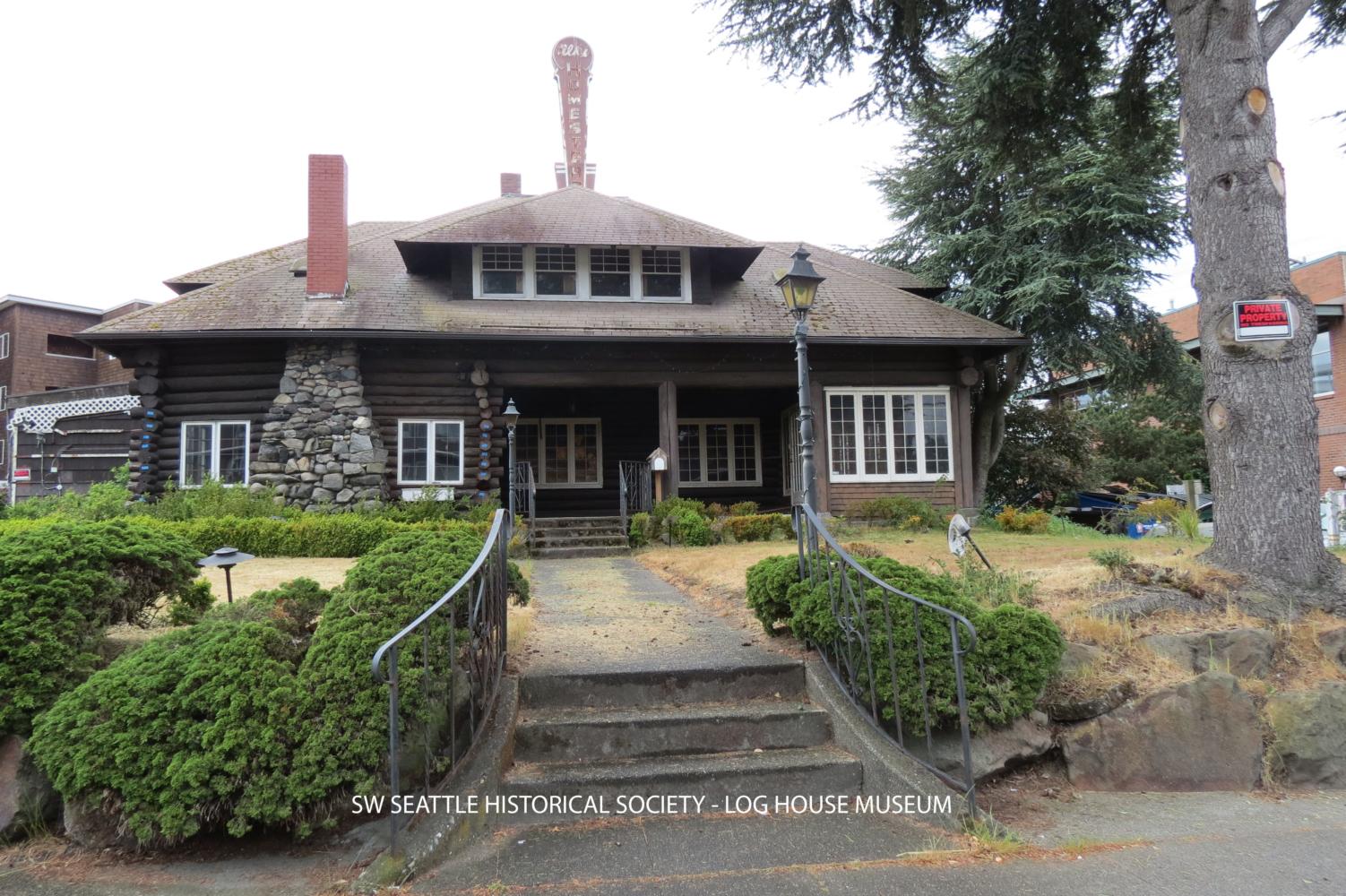 Alki HomesteadThe Alki Homestead was built out of local Douglas fir log, river rock in the fire places, and other local natural resources in 1904 for Seattle Soap Company owner, William J. Bernard, his wife Gladys, and their daughter Marie. In 1903, construction on the Alki Homestead began using the architect Fred L. Fehren with the builder most likely being Frederick A. Sexton. It is an early representation of a rustic bungalow craftsman style of home that became a staple of Puget Sound architecture. The front façade contains the main entrances which originally was a side entrance with the main entrances being those facing north or towards the beach. The reorientation of the house presumably occurred by 1912 with new development to the north along Alki Avenue SW. The wrap around porch extended approximately halfway along the back from the north side. In 1961 a wood framed kitchen addition extended the southern part of the western (or current back) of the homestead. In 1980 an outdoor patio added to the northern part of the western (or current back) of the homestead. The original floor plan indicates a dining room and brick fireplace in the southeast corner of the main floor. The living room claimed the entire north end of the main floor, surrounded on the east, north, and west sides by a wraparound porch and dominated by an open-hearth log and cobblestone fireplace on the south wall. The main floor’s southwest corner contained the kitchen. Upstairs held four bedrooms and the house had a total of two bedrooms, displaying the opulence of the owners as indoor plumbing was not yet available for much of the peninsula. The upstairs opened onto a gallery of which was seen the living room below. A stained glass skylight occupied the peak of the main roof. William and Gladys Bernard were well-known members of Seattle society in the 19th and 20th centuries. William was a prominent manufacturer as he served as the president of the Seattle Soap Company and of the Manufacturer’s Association. Gladys worked for children’s charities throughout Seattle. The Bernard’s frequently spent their summers vacationing at beach front camping resorts in the Alki area. In December of 1902, the Seattle Post-Intelligencer announced the Bernard’s intention to build a log house. They continued the tradition of summer camping at Alki while the Fir Lodge was built. In 1903, the Bernard’s hired Fred L. Fehren to construct Fir Lodge as their primary residence, fronting Alki Beach. They moved into the house by at least the spring of 1904. William J. Bernard was born in San Francisco in 1861 and came to Seattle in 1889. Gladys was originally from Cedar Rapids, Iowa and came to Washington in 1890. The two wed in 1892 with the ceremony occurring at the Governor’s residence in Olympia. William established the city’s first soap factory soon after he arrived in Seattle. Initially called the W.J. Bernard Company, it appeared as Seattle Soap Company in local newspaper advertising sections by at least 1894. The factory was located on the tidal flats, near the present day intersection of Airport Way and Lander Street. The soap company offered multiple cleaning products such as vegetable oils and soaps, soda, ash, grease, and tallow. Gladys worked for the benefit of children in the greater Seattle community, especially orphans and children of immigrant workers. She founded the Bernard Sunday School Mission and supported the Washington Children’s Home. She and William adopted two children, Marie and Billie. Marie came to the Bernard’s before the Alki home was built. The Bernard’s frequently entertained while living at Fir Lodge. In August of 1906, it was reported that the largest outdoor entertainment of the summer occurred there with the house and gardens decorated with ferns, cut flowers, and Japanese lanterns. This event was attended by Governor Alfred Mead. They sold the homestead in 1906 siting the remote location and difficulty with travel as the reason to moving back to Seattle proper. In 1906, the Seattle Auto Club bought the homestead and its lands for $16,000. The Bernard’s had bought the land and the home for $7,500 four years before from Lorena Smith, wife of Alfred Smith and owner of the Stockade Hotel. Lorena’s parents had bought the entire Alki Point acreage in the late 1860s from Doc Maynard. In 1907, the Seattle Auto Club took over the homestead and converted the house into their members’ clubhouse with multiple dining areas. The club used the exterior wraparound porch as informal dining space with table and chairs set up like an outdoor café. The former living and dining rooms became dining areas with the upstairs bedrooms converted to private dining spaces. During this time the SAC published their first tour book providing information on hotels and mechanics, organized trips to Cohasset Beach and Moclips Beach, paved the way for automobile travel to be allowed in Mt. Rainier National Park and later other national parks, promoted and sponsored a transcontinental race from New York City to Seattle, and met with representatives from Portland, Vancouver, and Victoria to discuss and promote a highway between Vancouver B.C. to Los Angeles, which became Highway 99. After the Seattle Auto Club sold the homestead in 1911, the next owners returned the house into living quarters as a private home and then for tenants. The one exception was in 1927 when an ad was found for the “Fir Lodge Inn” which offered rooms with “home cooked meals…affording bathing, boating, dancing, and beautiful play grounds for children.” In 1950 Svend and Margaret Nielsen bought the property and created the Alki Homestead Restaurant. In 1950, the Alki Homestead Restaurant was opened on the main floor with two apartments on the second floor. A rooftop sign was installed, the skylight was removed, and the upstairs gallery was closed off. The kitchen was expanded in 1953, followed by the west side addition in 1961. The wraparound porch was partially enclosed in the early 1960s and in 1980 a rear patio again reconfigured the western portion of the house. By 1987 the upstairs turned into the owner’s apartment, utility space, and a banquet room. A few owners came and went throughout the restaurant’s tenure but in 1962 Elmer H. and Doris Nelson bought the homestead, operated the restaurant, and lived upstairs until Doris’s death in 2004. In 2006, Thomas Lin bought the restaurant. In 2009 a fire damaged the roof and some windows on the southern and western parts of the homestead. Lin sold the homestead to Dennis Schilling in 2015 with preservation in mind. The construction of the Alki homestead between 1903 and early 1904 is a direct representation of the development of West Seattle and particularly the Alki neighborhood. Fir Lodge marks a turning point in Alki’s history, when its days as a rustic summer vacation locale for Seattle’s upper class yielded to the beginning of a year-round community. It is a rare remnant of Alki’s early days as a remote getaway for Seattle socialites. “Alki Homestead: This Place Matters” Historic Seattle National Trust for Historic Preservation 9 June 2010 http://historicseattle.org/alki-homestead-this-place-matters/ “Alki Homestead to be Restored” Historic Seattle 18 March 2015 https://historicseattle.org/alki-homestead-to-be-restored National Register of Historic Places Registration Form OMB No. 1024-0018. United States Department of the Interior National Park Service www.dahp.wa.gov/sites/default/files/WA_King_County_FirLodge_FINAL.pdf Sherrard, JR “Seattle Now & Then: Return of the Homestead” Seattle Now and Then 28 August 2015 https://pauldorpat.com/2015/08/28/seattle-now-then-return-of-the-homestead/ Soap Gazette and Perfumer, Volumes 9-10. Chas. S. Berriman Publisher, New York: 1 January 1907. “William Bernard, Seattle Soap Co.” The American Perfumer and Essential Oil Review, Volume 14. Perfumer Publisher Company, New York: March 1919-February 1920 |
|
Alki Statue of Liberty
The Sea Scouts and Boy Scouts troops of Seattle erected “Our Little Sister of Liberty” here at Alki Beach in 1952 as part of a national campaign to recognize the 40th Anniversary of the Boy Scouts of America. The project was called “Strengthen the Arm of Liberty” and was led by Jack Whitaker, a Kansas City Scout Leader, who encouraged scouts across the U.S to place these statues in their communities as an important reminder of the value of liberty and freedom cherished by all. Between 1948 and 1952 more than 200 replicas, which are 1/18th the size of the original in New York harbor, were placed in 39 states and 4 American territories. The monument stands as a symbol of the freedom and love of liberty in which we all believe and is a testimony to the citizen activism and the generosity of spirits of the Alki Beach community, donors from Seattle, and across the country. Due to the conditions from the weather and vandalism, the Alki Statue of Liberty was rejuvenated in 2007 and the new plaza was dedicated on September 6, 2008. The Alki Statue of Liberty has come to represent a monument of togetherness during times of remembrance and strife throughout America and the world. On September 11th, 2001, the Alki Statue of Liberty turned into a memorial and has done so ever since for such occasions. Information gathered from the Alki Statue of Liberty plaque and from information recorded in collections of the Log House Museum. |
Pioneer Monument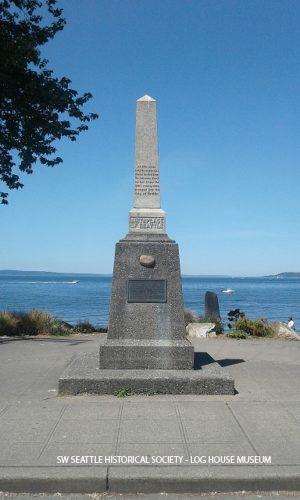 The Alki neighborhood was the landing place and initial settlement of the first Euro-Americans to homestead the Seattle area. Most of those settlers quickly moved to Seattle proper and the eastern portion of the Duwamish Peninsula where there are deeper port facilities. Yet, with the settlement of the Denny party, Alki remained continuously occupied ever since. This completed party left Illinois on April 10, 1851 and crossed Iowa and Missouri River by May 5th. From there they traveled along the north side of the Platt River and passed Fort Laramie on June 6th. June 21st the party crossed the summit of South Pass. On July 4th they reached Fort Hall and began traveling along the south side of the Snake River. It is at this point that Arthur Denny relates the only instance of hostile Native American interaction during their journey. Native Americans attempted to trade with the party but settlers refused to stop. The Native Americans shot at them, Arthur said, but did not hit them. The party decided that if any other Native Americans came into shooting range they would attempt to hit them but while the Indigenous made their presence known, they kept their distance from the travelers. On August 11, 1851 the party made it to The Dalles. Here John Low, C.D. Boren, and Arthur Denny chartered boats to take the families down river and the others sent teams over the mountains by way of Barlow’s Pass. Along the Burnt River, Arthur Denny met a man named Brock whom, according to Denny, told the party about Puget Sound as an area to settle rather than Willamette Valley where the party was originally headed. Arthur stated that this mysterious man named Brock insisted that all the good land was already spoken for in Willamette Valley but that another prime area for settlement lay just north. “My attention was thus turned to the Sound…” Arthur Denny later wrote. They arrived in Portland on August 22nd. Arthur Denny, his wife and at least one of their children fell sick with ague, otherwise known as malaria or some form thereof where fever and shivering are the main symptoms. This delayed the party from travelling until autumn. In September, J.N. Low, Lee Terry, and D.T. Denny drove Low’s cattle over the Chehalis River with the purpose of examining the country. Low and Terry concluded that they would locate the town site at Alki Point. David Denny, John Low, and Lee Terry went ahead from Portland by land and canoe to find an area to create their settlement. On September 28, 1851, this small group reached Alki Point which they decided offered the best site for a future community. John and Lee settled their homestead claims in accordance to the requirements specified in the Homestead Act. David was too young to claim land so he remained at Alki with Lee to protect the claims and build cabins while John returned to Portland to retrieve the rest of the party. John carried with him to Portland a letter from David to Arthur writing, “Dear Brother, come as soon as you can. We have found a valley that will accommodate one thousand families…” On a stormy morning, November 13, 1851, Low returned to Alki aboard the schooner Exact with the rest of the Low and Denny families, the Bell family, and the Boren family. They were met by David Denny as Lee had gone off to Nisqually to get tools from the Hudson Bay Company. In 1905, Arthur Denny’s daughter Lenora donated the Pioneer Monument to commemorate and honor her parents and other founding families. The monument was originally located on the grounds of the Stockade Hotel. The monument was moved in 1926. The Stockade Hotel was built in 1901by Alfred A. Smith and his wife Lorena Hansen Smith. The hotel was named the Stockade because of the vertical placement of the logs in its design. The hotel was billed as one of the region’s best resorts as it attracted Seattle’s wealthy citizens and served as a social hub for the Alki area, including as the polling place for Alki residents to vote in the annexation elections to West Seattle on October 6, 1906 and May 25, 1907. Cottages were built behind the hotel to use for summer vacations but were also used during the Depression for living purposes. The hotel was demolished in 1936. The settlers were named the Denny party because there were so many among them who were members of the Denny family, though admittedly the party could have been named after any number of family groupings in this party. Included in the Alki settlement party was: Arthur Armstrong Denny, age 29 Mary Ann Boren Denny, Arthur’s wife, age 29 Louisa Catherine Denny, age 7 Margaret Lenora Denny, age 4 Rolland Herschel Denny, age 2 months. David Thomas Denny, brother of Arthur, age 19 Louisa Boren, sister of Mary Denny, age 22 Carson Dobbins Boren, age 27 Mary Boren, Carson’s wife, age 20 Gertrude Lavinia Boren, age 1 John Nathan Low, age 31 Lydia Colborn Low, John’s wife, age 31 Mary Low, age 9 Alonzo Low, age 7 John Low, age 4 Minerva Low, age 2 William Nathaniel Bell, age 34 Sarah Ann Bell, William’s wife, age 36 Laura Keziah Bell, age 9 Olive Julia Bell, age 5 Marry Virginia Bell, age 4 Lavina Bell, age 10 months Charles Carrol Terry, age 21 Leander “Lee” Terry, age unknown Bass, Sophie Frye When Seattle Was a Village. Lowman & Hanford Co., Seattle: 1947. Burrows, Alyssa “Automobile Club of Seattle Predecessor of AAA Washington, forms on September 23, 1904.” History Link Essay 5718. 21 July 2004. www.historylink.org/File/5718 Denny, Arthur A. Pioneer Days on Puget Sound Third Place Press, Seattle: 2010 Lange, Greg. “Seattle and King County’s First Non-Indian Settlers” History Link Essay 160 15 October 2000. www.historylink.org/file/1660 National Register of Historic Places Registration Form OMB No. 1024-0018. United States Department of the Interior National Park Service www.dahp.wa.gov/sites/default/files/WA_King_County_FirLodge_FINAL.pdf “West Seattle” Seattle Municipal Archives https://www.seattle.gov/cityarchives/exhibits-and-education/online-exhibits/annexed-cities/west-seattle West Seattle Memories: Alki A Memory Book Project of the Log House Museum and the Southwest Seattle Historical Society. Southwest Seattle Historical Society: 1999. Wright, Mary C. More Voices, New Stories: King County, Washington’s First 150 Years. Pacific Northwest Historians Guild: 2002. |
First Cabin Site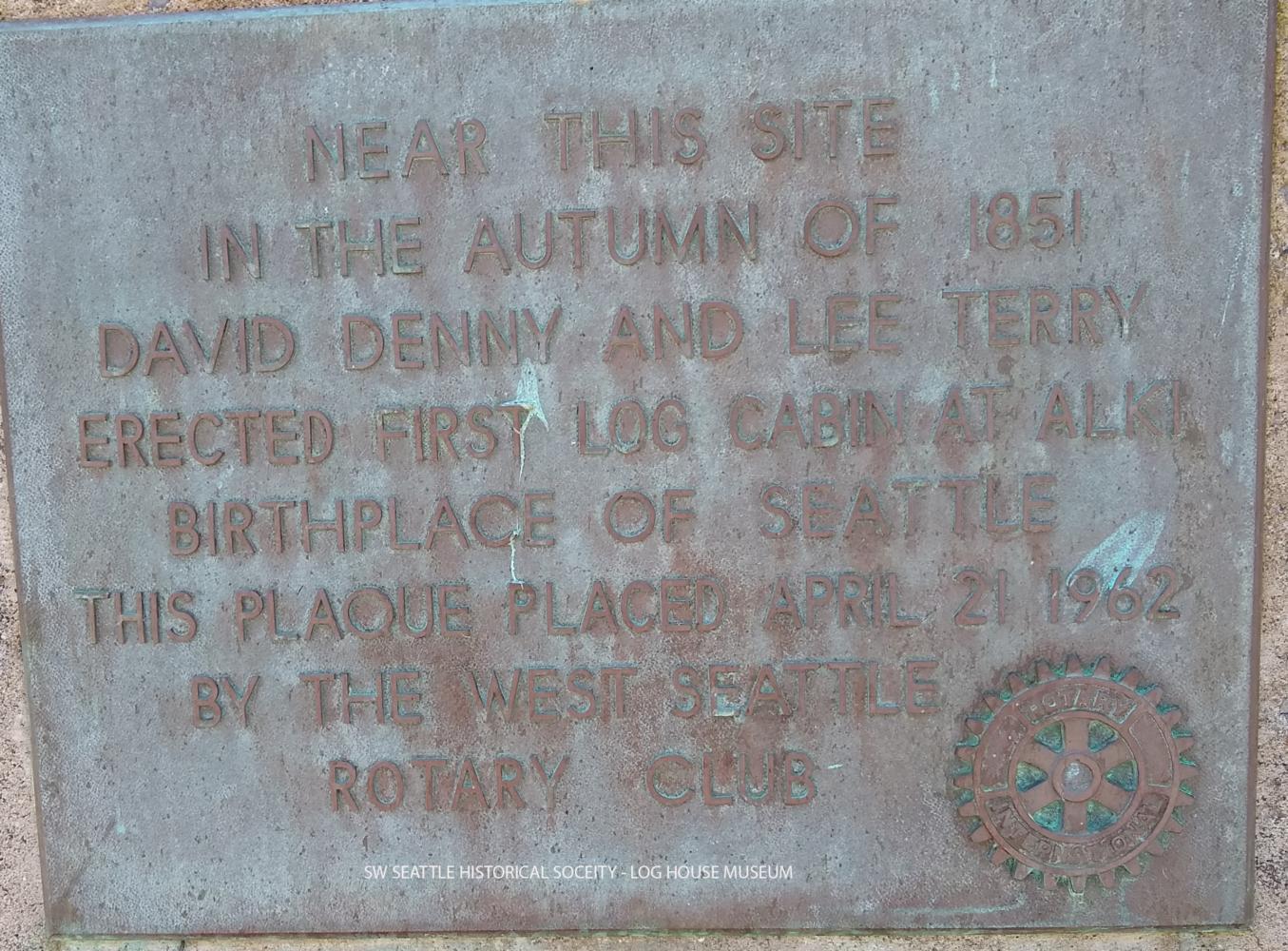 When David Denny, John Low, and Lee Terry first decided upon Alki as their settlement site, they knew their first task was to create a shelter for their first winter with the rest of the party. While John Low returned to Portland to gather the group, David and Lee turned to making the first permanent structure on Alki. Interestingly, this cabin was built for John Low and his family as he took this land as part of his Donation Land Claim.* When the party reunited on November 13, 1851, all twenty-four of them took shelter in the one cabin from the rain, which reportedly fell more or less every day. Reportedly, the women began to cry when they were told the unfinished cabin was for all of them to live. More cabins were built for each family and quickly used up the timber they could get to without an oxen team. The settlers used split cedar to build the homes. A brig Leonesa came to anchor at Elliott bay after seeing that it was inhabited by Euro-Americans. The party was contracted to load the vessel with timber piles. Lee went to Puyallup and drove a team of oxen to complete the cargo job. The Native Americans came out shortly after the Denny party landed on Alki out of curiosity, including Seattle. They then camped near the settlers to help them learn this new land but also from protections from Northern Native Americans. The settlers did not want to tell the Native Americans not to camp near them for fear of offending them. They used sign language to talk and Chinook. Chinook was a jargon that was used as a trade medium between Puget Sound Native Americans and early explorers from the Hudson Bay Company that the settlers learned. The Terry’s, being from New York, initially named the area New York but later changed it to Alki. The settlement was christened New-York Alki meaning “New York eventually” in the Chinook jargon. Eventually, “New York” was dropped therefore finally naming the settlement, Alki. In February of 1852, Denny, Bell, and Boren started looking for land claims for their own and looked toward Elliott Bay. On February 15th, three claims were made, one for each family. *The Donation Land Claim Act of 1850 gave 160 acres of land per adult on the claim. This act became the greatest incentive for emigration to the Pacific Northwest including those of the Denny party and Doc Maynard. Bass, Sophie Frye When Seattle Was a Village. Lowman & Hanford Co., Seattle: 1947. Denny, Arthur A. Pioneer Days on Puget Sound Third Place Press, Seattle: 2010. |
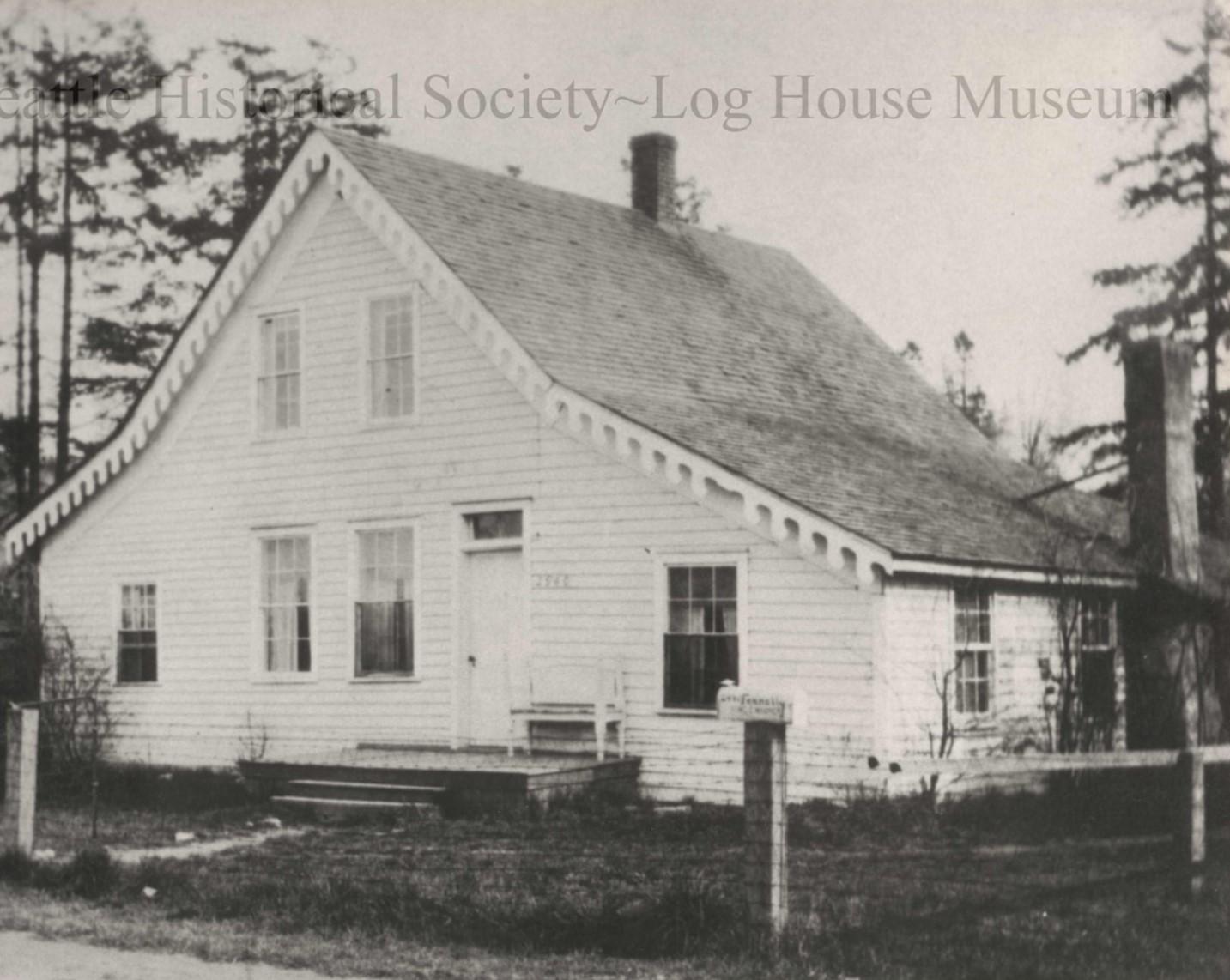 Doc Maynard HomeDavid Swinson Maynard was born in Castleton, Vermont on March 22, 1808. He attended Castleton Medical School and received the nickname “Doc” there from his mentor Dr. Theodore Woodward, Professor of Obstetrics and Surgery. Doc became a medical doctor and the operator of a medical school in Ohio until the financial panic of 1837 swept everything away. Maynard left his wife and two children to find his fortune out west, just like the thousands of others who migrated along the Oregon Trail. His goal was to relocate in California. Doc Maynard crossed the plains on a mule in 1850. Maynard heard of people dying of cholera behind him and turned around to help. He helped migrants stricken with cholera near Fort Kearney on the Platte River and took care of the Broshears family. Israel Broshears passed away and left widowed Catherine. Maynard stayed with this group and drove oxen, milked cows, and performed other chores while on their journey. The travelers reached Oregon and from there Maynard went on to Smither, later called Olympia, and Catherine to Tumwater where her brother was waiting for her. However, along the trail, the two fell in love. Maynard cut and stacked cord wood and sold the wood in San Francisco, eventually opening a store. He heard of opportunities on Elliott Bay, closed his failing business, and canoed with Seattle and other Duwamish Native Americans. On March 31, 1852, Maynard joined the other families at Alki. Maynard went to work with Seattle to establish a salmon fishing and packing business. He decided to join William Bell, Arthur and David Denny, Carson Boren and their families to a new site across the bay. He hired the Duwamish to build a cabin on present day Pioneer Square, near Yesler Way. Shortly thereafter, Maynard and Seattle decided to organize another fishery at a Native American village, dziolzula’lich or Duwamps, on the east shore of Elliott Bay. By the summer of 1852 and at the urging of Doc Maynard, American settlers who took claims near the village named the settlement after their patron and protector, Seattle. In Seattle, Maynard also had good stores called “Seattle Exchange” and sought out skilled people needed in their settlement to move them to Puget Sound. In 1853, Arthur Denny, Carson Boren, and Doc Maynard decided to plat adjacent holdings for the township of Seattle. Maynard obtained the first divorce granted by the Oregon Territorial Legislature from his first wife, Lydia, and in January of 1853 he married Catherine Broshears. Washington achieved territorial status also in 1853 and Maynard became the Indian agent for the Seattle area. The territorial Governor, Isaac I. Stevens, held his first meeting with Native Americans in front of Maynard’s store in 1854. Poor communications and misunderstandings led to the Battle of Seattle on January 26, 1856. Maynard lost confidence in the burgeoning settlement of Seattle after the Indian Wars of 1856 and the coming rifts with pre-Civil War sympathies as he was a Democrat surrounded by Republicans. Maynard traded his 290 acres, much of present day Pioneer Square, for a 319 acre farm at Alki owned by Charles Terry. This Alki property soon became entangled in a complicated dispute between Maynard’s first wife, Lydia, and his current wife, Catherine, when she suddenly arrived at Alki and demanded her half of the land claim. While the claim was being disputed, Doc lived in his house with both his current and his ex-wife. Lydia eventually lost the land dispute because she never lived on the land herself. Doc Maynard opened the first hospital where Catherine Maynard was a nurse. She opened the first reading room that was the beginnings of the Seattle Public Library System. Doc Maynard ended up becoming Seattle’s first first physician, merchant, Indian agent, and Justice of the Peace. Now the oldest home in all of Seattle, it is used as a residential rental home. While it is wonderful to have the house still standing and in use, it is concerning that this house is not registered as a nationally recognized historic site. With the National Register of Historic Landmarks status comes the protection of laws designed to preserve these historic sites for future generations. On June 15, 2017, Doc Maynard’s house went up for sale with offers due for the home on Monday, June 19th. As of July 1, 2017 the sale of the home was pending. Bass, Sophie Frye When Seattle Was a Village. Lowman & Hanford Co., Seattle: 1947. Buerge, David M. “Chief Seattle and Chief Joseph: From Indians to Icons” University of Washington Libraries Digital Collectionshttps://content.lib.washington.edu/aipnw/buerge2.html Denny, Arthur A. Pioneer Days on Puget Sound Third Place Press, Seattle: 2010 Nordstrand, Dorothea “Doc Maynard: Seattle Pioneer by Dorothea Nordstrand” History Link Essay 4273 www.historylink.org/File/4273 Rochester, Junius “Maynard, Dr. David Swinson (1808-1873)” History Link Essay 315. 11 October 1998. www.historylink.org/File/315 |
Pre-Settlement History of the Pacific Northwest and Puget Sound The Sunfish Restaurant mural is painted on the eastern side of the building. This mural represents a favorite camping spot for one of the owners of the restaurant, Kalaloch. Kalaloch is located on the western most portion of Washington State. These beaches have seen the coming early explorers from Spain, Russia, France, England, and the newly established United States of America. It is here, while celebrating one of many of Alki’s local businesses and enjoying the view of this artwork, that we invite you to enjoy the view of Alki around you and the water to the north while learning about the history of Puget Sound before settlement. To the Native Americans Alki was known as Prairie Point because of the grassy openings between the trees on the shelf above the beach. The Native Americans used the land often and was considered for a satellite trading post for Fort Nisqually and the Hudson Bay Company. In 1833, Prairie Point was surveyed by a British physician and Fort Nisqually factor, William Tolmie. Tolmie wrote: A fort well garrisoned would answer well as a trading post on the prairie where we stood. It would have the advantage of a fine prospect down the sound and of proximity to the Indians, but these advantages could not compensate for an unproductive soil and the inconvenience of going at least half a mile for a supply of water. Tolmie’s is the first western account of many of the places and peoples who would play central roles in the story of Alki and Seattle. The first official American to Puget Sound in 1841 was of the U.S. Exploring Expedition led by Lieutenant Charles Wilkes. The expedition was authorized by President Andrew Jackson’s congress. The expedition started on August 18, 1838 and ended nearly four years later and after they had encircled the globe. Wilkes captained the expedition that led them to survey Antarctica, Hawaii, and the Columbia River. The expedition carried up-to-date scientific instruments and experts in the field of botany, philology (comparative science of language), horticulture, conchology, and mineralogy. One of the other reasons for this naval expedition was to strengthen American claims to the north of the Columbia River. They mapped and measured the bays and inlets while also gaining scientific knowledge of the region. Many places Wilkes surveyed were earlier overlooked by George Vancouver in his 1792 Royal Navy expedition, including Prairie Point. Prairie Point obtained its first colonial name in the summer of 1841 after the Wilkes expedition’s physician, calling it Point Roberts. Wilkes also named Elliott Bay in 1841; however it is not specified to whom the bay was named after as there were three men with the surname Elliott on the expedition, or if the name came from another source outside of the expedition. Wilkes obtained much of their information on Puget Sound from Hudson Bay Company settlers and missionaries at various posts from May 1, 1841 to August 2, 1841. During this expedition, it was noted of the Native Americans: All these Indians may be termed Nomadic for they seldom occupy the same spot over a few months together but change their residence in order to approximate the places where they are supplied with food. These Indians suffer little inconvenience in their changes of residence; for, having but a few chattels, they can remove at a few moments’ notice; and after landing at an entirely strange place, they are at home the moment their fires are lighted. This statement reflected well-established patterns of summer migration to and from resource sites; had the expedition come in the winter, they would have found indigenous people living in large permanent winter towns. To Wilkes, the Native Americans’ living situation implied that they would not stand in the way of white settlements. Additionally, at this point, Wilkes was meeting the Native Americans when their numbers were at a low point as smallpox, measles, and influenza created a mortality rate as high as 60% in the 1830s and 1840s. Chief Seattle received explorers and visitors with warm welcome and aid, which earned him the reputation of a friend to the whites. In the summer of 1850, Seattle made a speech to visitors Isaac N. Ebey and B. F. Shaw when they visited Elliott Bay. According to Shaw, Seattle requested in this speech that they settle among his people and trade. Ebey gave a glowing description of Seattle and the Native Americans in the Oregon Spectator, encouraging settlement in the Duwamish River Valley. Seattle actively sought out settlers for business and trade and built contacts when in Olympia. Seattle organized the fishery businesses on Alki and Elliott Bay with San Francisco merchant Captain Robert Fay in 1851. Samuel Hancock is one of the first American settlers to Puget Sound and came to Prairie Point or Point Roberts in 1849. He was made aware that the Native American people were still in charge of Puget Sound when scores came out in curiosity of his arrival. He treated them to gifts to obtain information about the soil and chose to move on. Captain Robert Fay was a New Englander in the whaling industry who turned his attention west and looking for opportunity in Puget Sound. In 1851 Fay found workers in the Native Americans under the leadership of Seattle to catch and preserve salmon to be shipped to San Francisco. Fay offered passage to David Denny, John Low, and Charles Terry on September 25th to Prairie Point and then he returned to Olympia afterward. It is through Fay that the Denny party was transported up to Alki and through Seattle that Doc Maynard came to work and live in Alki, later to create the Seattle settlement. All these parts came together to create the neighborhood and the city we see today. Buerge, David M. “Chief Seattle and Chief Joseph: From Indians to Icons” University of Washington Libraries Digital Collections https://content.lib.washington.edu/aipnw/buerge2.html Lange, Greg. “Seattle and King County’s First Non-Indian Settlers” History Link Essay 160. 15 October 2000. www.historylink.org/file/1660 Rochester, Junius “Vancouver, George (1758-1798) History Link Essay 5359. 3 April 2003 www.historylink.org/File/5359 Rochester, Junius “Wilkes, Charles (1798-1877)” History Link Essay 5226. 17 February 2003 www.historylink.org/File/5226 “Wilkes Exploring Expedition” Naval Institute Archives 14 May 2011. https://www.navalhistory.org/2011/05/14/wilkes-exploring-expedition Wright, Mary C. More Voices, New Stories: King County, Washington’s First 150 Years. Pacific Northwest Historians Guild: 2002. |
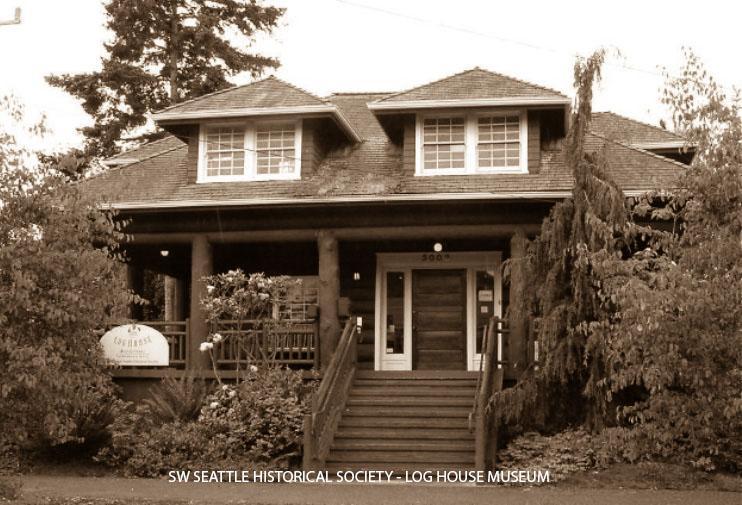 Log House MuseumThe Log House Museum was one of five smaller houses that originally surrounded the Alki Homestead. Built around 1904, it also belonged to the Bernard Family and was likely used as a carriage house or servant’s quarters. The Southwest Seattle Historical Society purchased the building in 1995 and began a restoration to preserve the house and use it as their museum. The Log House Museum cost close to a million dollars to restore and is just a quarter to a third of the size of the Alki Homestead. The Totem Pole in the front of the museum on the eastern side of the building was originally located at Belvedere Viewpoint Park and made by Michael Morgan and Bob Fleischman. Morgan and Fleischman were both engineers at Boeing and created the pole to replace the original 1939 Bella Coola Pole on Belvedere Park. The Viewpoint totem poles started with J. E. “Daddy” Stanley, owner of Seattle’s Ye Olde Curiosity Shop, who donated the original pole created by Bella Coola Indians from Canada. This pole was meant to be sold and did not tell an ancestral story. By the 1960s, the pole was rotting. Therefore it was replaced by Morgan and Fleischman’s totem pole in 1966, as a replica of the original. In 2004, it was discovered that this pole was being eaten at the center by carpenter ants. In 2006 it was removed for restoration by the local art installation and restoration company, Artech. Artech’s Senior Technical Consultant, Roger Waterhouse, welder Cody Thomaselli, and installer Glenn Kearney administered the installation of the restored Morgan and Fleischman totem pole in front of the Log House Museum on June 3, 2014. The current Belvedere Viewpoint Park totem pole was carved by hand by a fifth generation descendent of Chief Seattle, Michael Halady. “Alki Homestead to be Restored” Historic Seattle 18 March 2015 https://historicseattle.org/alki-homestead-to-be-restored Diltz, Colin “Totem pole has new home” The Seattle Times 2 June 2014 http://www.seattletimes.nwsource.com/html/picturethis/2023759662_totempolehasnewhome.html National Register of Historic Places Registration Form OMB No. 1024-0018. United States Department of the Interior National Park Service www.dahp.wa.gov/sites/default/files/WA_King_County_FirLodge_FINAL.pdf Sherrard, JR “Seattle Now & Then: The View from Belvedere Viewpoint” Seattle Now And Then 12 June 2010. https://pauldorpat.com/2010/06/12/seattle-now-then-the-view-from-belvedere-viewpoint/ |
|
Alki Homestead PreservationIn 2009 the Alki Homestead was placed on Washington State’s Most Endangered Historic Preservation List and was on their Watch List in 2016. The list dates back to 1992 and was created to raise awareness of historic properties that face demolition by redevelopment or neglect. The list is created by concerned citizens and organizations that nominate historic sites. It also assists historic preservation advocates to develop strategies aimed at removing these threats. A “Homestead Coalition” was formed from Historic Seattle, the Southwest Seattle Historical Society, 4Culture, and the Washington Trust for Historic Preservation. On July 4, 2010 nearly two hundred supporters gathered at the Alki Homestead to declare “This Place Matters” in the hopes of preservation and restoration of the first residential home in Alki. During the winter of 2009 the Alki Homestead Restaurant suffered a fire and had been closed ever since. The then owner, Tom Lin, was planning to demolish and replicate the building. After the gathering on July 4th, Lin reconsidered his approach to the property and instead committed to its preservation and restoration. On March 13, 2015, Lin sold the Homestead to Mercer Island builder and investor Dennis Schilling who has since worked to rehabilitate the National Historically land-marked structure. On June 15, 2015, a “group hug” was held to start the celebration of the Homestead restoration. 1,000 students, teachers, parents, and local office holders arrived to show support and love for the Alki Homestead. “Alki Homestead: This Place Matters” Historic Seattle National Trust for Historic Preservation 9 June 2010 http://historicseattle.org/alki-homestead-this-place-matters/ “Alki Homestead to be Restored” Historic Seattle 18 March 2015 https://historicseattle.org/alki-homestead-to-be-restored Eals, Clay “Alki Homestead to be restored!” 21 March 2015 https://www.youtube.com/watch?v=hBgW8bI_0u8 “New hope for Alki Homestead/Fir Lodge” 4Culture 31 January 2011 www.4Culture.org/2011/01/new-hope-for-alki-homestead-fir-lodge/ |

